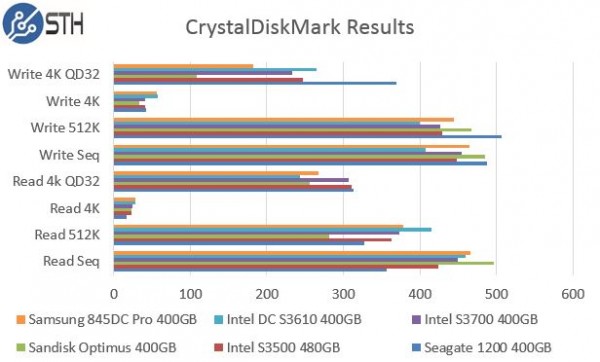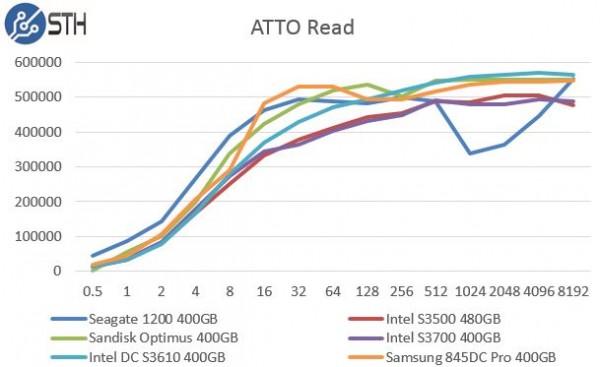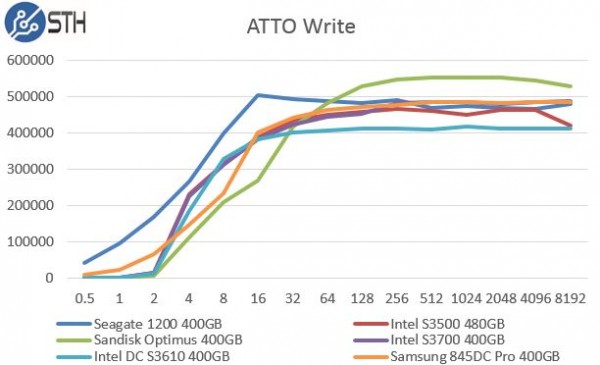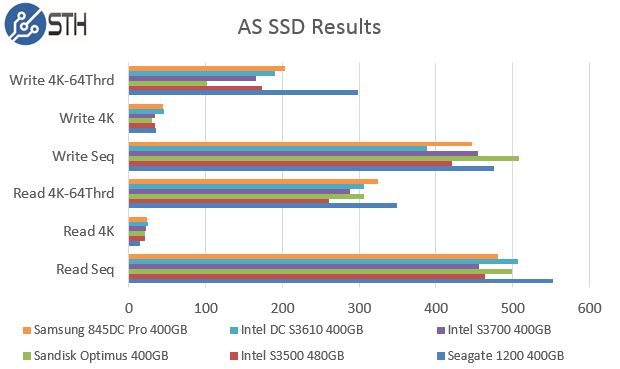Not long ago, Intel announced the DC S3610 and DC S3710 families of enterprise data center SSDs. The Intel DC S3710 was an update to the very successful DC S3700 series which was adopted by virtually every major OEM. The Intel DC S3610 was to be a new drive between the DC S3500 and DC S3710 series. Intel announced the NVMe based P3500, P3600 and P3700 series families so this segmentation makes sense.
What is interesting is that it seems as though Intel did not sample the DC S3610 series heavily, so there is a dearth of information on them. We will have our full review next week but we wanted to get some information out there as soon as possible. Note: the drive we are using today is a retail purchased sample and was not provided by Intel. Frankly, I was curious and so we just bought one and then immediately put it into its 24 hour pre-conditioning cycles and benchmarking cycles. More to come on this next week but we did want to provide a preview of the results we are seeing.
Test Configuration
Since we are going to assume the use of already released hardware, we are using a legacy system for testing across the test suite:
- Motherboard: Gigabyte GA-7PESH3
- Processors: Dual Intel Xeon E5-2690 (V2)
- SAS Controller: LSI SAS 3008
- RAM: 64GB DDR3L-1600MHz ECC RDIMMs
- OS SSD: Kingston V300 240GB
We are using a SAS controller so one cannot compare our SATA results directly to consumer-driven setups where a SATA SSD is connected to an Intel PCH port. There is a latency penalty for going over the PCIe bus to a controller to SAS. It also is a reason NVMe is going to be a game changer in the enterprise storage space. This impact is very tangible and we will have a piece comparing the SAS 3008 with a few other SATA controllers soon.
Intel DC S3700 400GB SSD Quick Benchmarks
For our quick tests during this part of the series we will just provide the quick benchmarks with only a bit of commentary. The results should be fairly straightforward and we have added a few results for comparison purposes.
AS SSD Benchmark
AS SSD is a solid benchmark that does not write compressible data to drives. The result is perhaps one of the best workstation SSD benchmarks available today.

As we have seen previously, Intel’s latest SSDs generally have very good 4K performance and are tuned for 4K and larger transfers. At higher queue depths we can see the reads and writes are in the top half of the results we have in this comparison group. There is certainly a pick-up from the S3500 series in terms of performance across the spectrum except for the AS SSD sequential write results.
CrystalDiskMark
CrystalDiskMark is another benchmark which gives non-compressible read/write numbers. This is in contrast to the ATTO Benchmark used by LSI/ Sandforce and its partners when they market a given solid state drive.

On the CrystalDiskMark results, we see the drive performs well compared to the previous generation S3500 and S3700 SSDs from Intel and are competitive on some tests with the SanDisk Optimus Ascend unit we were testing.
ATTO Benchmark
The value of the ATTO benchmark is really to show the best-case scenario. ATTO is known to write highly compressible data to drives, which inflates speeds of controllers that compress data like LSI/ SandForce does prior to writing on a given solid state drive.

In terms of read optimized workloads, we see the Intel DC S3610 SSD perform well throughout ending at some extremely high terminal numbers towards the larger block size transfers. Keeping up with the SAS SSDs and the Samsung 845DC Pro is not an easy task for a SATA3 SSD here.

Here we can see a few optimizations clearly at work. Both the Seagate 1200 and the Samsung 845DC Pro perform much better on the very small write sizes. The SanDisk Optimus architecture is optimized for larger sequential workloads. The disappointing feature we saw here is that the Intel DC S3610 falls short of other drives after the 32k size.
Closing Thoughts
Again, these are just initial benchmarks but there are a few trends emerging. First, we can see that the Intel DC S3610 performs about how we would expect for a modern SATA 3 SSD. At this point, we know that SSDs are now interface limited with SATA. We have drives like the Toshiba PX02SMF040 which can saturate a 12gbps SAS3 bus and plenty of NVMe drives that are much faster. Intel is targeting a different market here though. They now have a drive with a rated endurance level between that of the S3700 (10 DWPD) and the S3500 (0.3 DWPD). SanDisk has significantly more endurance levels, Samsung, Hitachi, Toshiba and other enterprise manufacturers are following the same segmentation pattern. Intel does have an excellent reputation for reliability which is going to be a primary driver for many OEMs who will use this drive. More to come soon.




